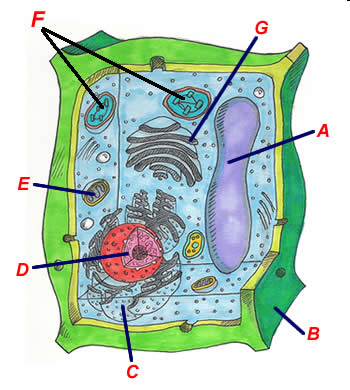Multiple Choice
Identify the
choice that best completes the statement or answers the question.
|
|
|
1.
|
The invention of the microscope made it possible for people to discover
a. | plants. | b. | skin. | c. | animals. | d. | cells. |
|
|
|
2.
|
Which of the following statements is part of the cell theory?
a. | Only plants are composed of cells. | b. | All cells are produced from other
cells. | c. | Cells can be produced from nonliving matter. | d. | Cells are one of
several basic units of structure and function in living things. |
|
|
|
3.
|
Which of the following statements is NOT part of the cell theory?
a. | Cells are the basic unit of structure and function in living
things. | b. | All cells are produced from other cells. | c. | Only animals are
composed of cells. | d. | All living things are composed of
cells. |
|
|
|
4.
|
Cells in multicellular organisms
a. | all look the same. | b. | all have the same
structure. | c. | are often quite different from each other. | d. | are the same size in
every part of the organism. |
|
|
|
5.
|
Which organelles release chemicals that break down large food particles into
smaller ones?
a. | endoplasmic reticulum | b. | Golgi bodies | c. | lysosomes | d. | vacuoles |
|
|
|
6.
|
Depending on the cell, one thing a cell wall and cell membrane may have in
common is
a. | either may separate a cell from its environment. | b. | both are present in
all cells. | c. | neither can prevent harmful materials from entering the cell. | d. | one cannot exist
without the other. |
|
Modified True/False
Indicate
whether the statement is true or false. If false, change the identified word or phrase to make
the statement true.
|
|
|
7.
|
You can’t see the cells in your body because most of them are very
small. _________________________
|
Matching
|
|
|
 Match the letter with the cell
organelle Match the letter with the cell
organellea. | Water Storage | e. | Power House | b. | Gives plant ridged
structure | f. | Absorbs light for
photosynthesis | c. | A maze of transport and cooling passage ways | g. | Packages Proteins | d. | d |
|
|
|
8.
|
Nucleus
|
|
|
9.
|
Golgi Body
|
|
|
10.
|
Cell Wall
|
|
|
11.
|
Chloroplast
|
|
|
12.
|
Vacuole
|
|
|
13.
|
Endoplasmic Reticulum
|
|
|
14.
|
Mitochondria
|